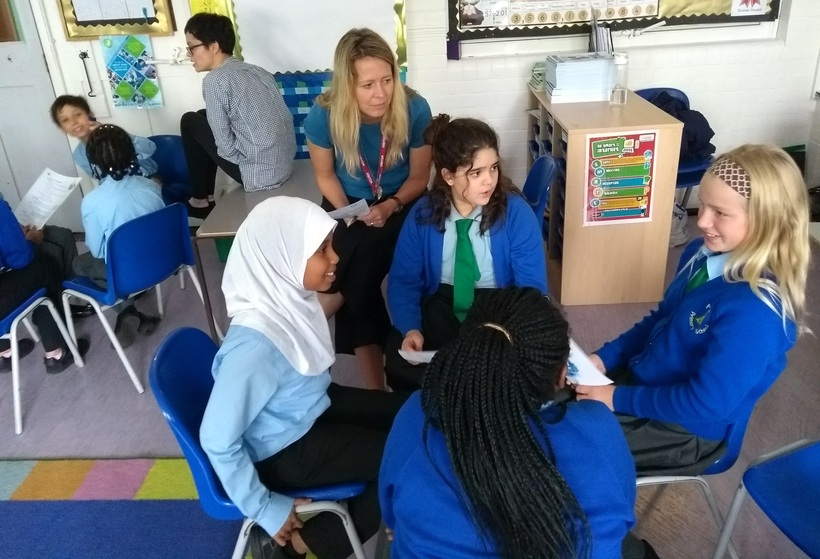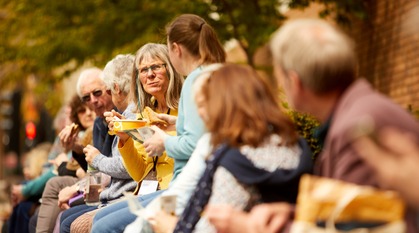Post-pandemic peace in the classroom
Isabel Cartwright outlines how keeping peace on the curriculum means we can build back better in our schools.

"Good Morning, Ada."
"Good morning", my 3-year-old daughter answers her teacher.
"Good Morning Isabel."
"Good morning", I reply cheerfully, before realising the teacher is talking to a 3-year-old Isabel in the online classroom. I cringe.
It hasn't been easy getting used to 'home schooling' two children or keeping my daughter inside our 7th floor flat this week as she self-isolates due to a Covid case in her school. But I remind myself that my neighbour kept her 2-year-old inside for three months during the first lockdown. A single mum with no family in the UK, she was terrified of getting ill. We took her rubbish out and our kids chatted through the door. We haven't all been in the same boat during this pandemic, but we've been affected by the same storm. Collective traumas and personal ones. It's been tough, especially for those already on the wrong side of structural inequalities. Schools too have had to react to these pressures.
We don't want to see schools return to normal. In the last couple of years there has been a staggering rise in permanent school exclusions in England, a revolving door of school exclusions in Scotland, growing pressure (and a counter-movement) to introduce 'zero tolerance' behaviour policies, and focus on attainment. The Chief Inspector of Prisons for England and Wales noted that 89% of children in detention had been excluded from school (PDF), raising concerns about the 'exclusion-to-prison pipeline'. England's Children's Commissioner also highlighted the prevalence of 'isolation booths', their impact upon mental health, and disproportionate impact upon children with special educational needs. Now that children have lost months of time from the classroom, this pressure is even greater. More than ever, "balancing the scales between outcomes (test scores) and emotional wellbeing" is crucial.
RESTORE-ing our schools
At the beginning of lockdown, a group of researchers, practitioners and school leaders, including several Quakers and Quaker organisations, came together to think about how they could support schools during this time. They developed the RESTORE framework, which will help inform our build back better work. The first four letters stand for Recognise, Empathise, Safety and Trauma, and are connected to what has happened and its effects on us. The last three letters, relate to Opportunity, Relationships and Engagement. They are key to how we go forward, to how we “build back better". The RESTORE resources have been downloaded tens of thousands of times around the world. They seek to re-build relationships between staff, pupils and parents and consider the social and emotional impacts this collective experience is having.
None of this is easy. When you're working in a challenging school, and I've worked in two that were labelled 'the worst school in Britain', it's easy to see approaches which emphasise relationships as a luxury or perhaps as naïve, something for nice schools where children already know how to sit and listen. When violence is a real danger, schools have to prioritise safety. Clear and consistent 'peace-keeping' policies are crucial, such as extra staff on duty, the use of security cameras, or a police presence. But it takes a lot of energy to 'keep' the peace, as it's reliant upon you or externally imposed measures. It's tempting to see the 'zero tolerance' approach to behaviour as the answer. If you catch the small things, the logic goes, you won't have to worry about bigger issues. You minimise disruption and maximise learning time. The correct shade of socks, no talking in the corridor, no glancing out the window are rules some schools enforce rigidly.
Creating the conditions for human flourishing
But if you keep the peace through evermore severe behaviour policies, you deny young people the chance to take responsibility for their actions, to contribute to the life of the school community, to exercise their rights, to build a trusting, caring community. Young people's problems might become invisible, but they've only been displaced. Approaches to behaviour in school often get polarised as disciplinarian versus caring. This is unhelpful. To build what Johan Galtung called 'positive peace' in your school, you need not only the absence of violence, but the conditions for human flourishing. As Hilary Cremin and Terence Bevington argue, a balance of peace-keeping, peace-making and peace-building is needed for "positive peace in schools". The West Midlands Quaker Peace Education Project, or Peacemakers, offers online training in how to create these conditions.
Similarly, if schools want to nurture 'ethical informed citizens of the world' as the Welsh curriculum seeks, they need to give them the chance to own and respond to conflict as peace-makers, and have a genuine voice in their community as peace-builders. Schools and communities need to build restorative cultures and systems for this to happen.
Building back better
I've worked with disengaged young people at risk of gang involvement. They flourished when engaged in activities that helped them feel positive about themselves. The same restorative ethos can apply to the whole school. These approaches aren't a luxury or an add-on. They're not naïve. They work, as many schools around the country are proving – even when it's counter to a behaviourist orthodoxy. Building back better will mean spreading these models with or without government permission.
In the pandemic, it's hard to picture the world my daughter Ada will grow up in. But it is clearer than ever that we are all connected, that we do need each other for company, care, love and meaning. If we want it to be 'better' we need education that doesn't simply enforce peace from above, but builds peace together.


